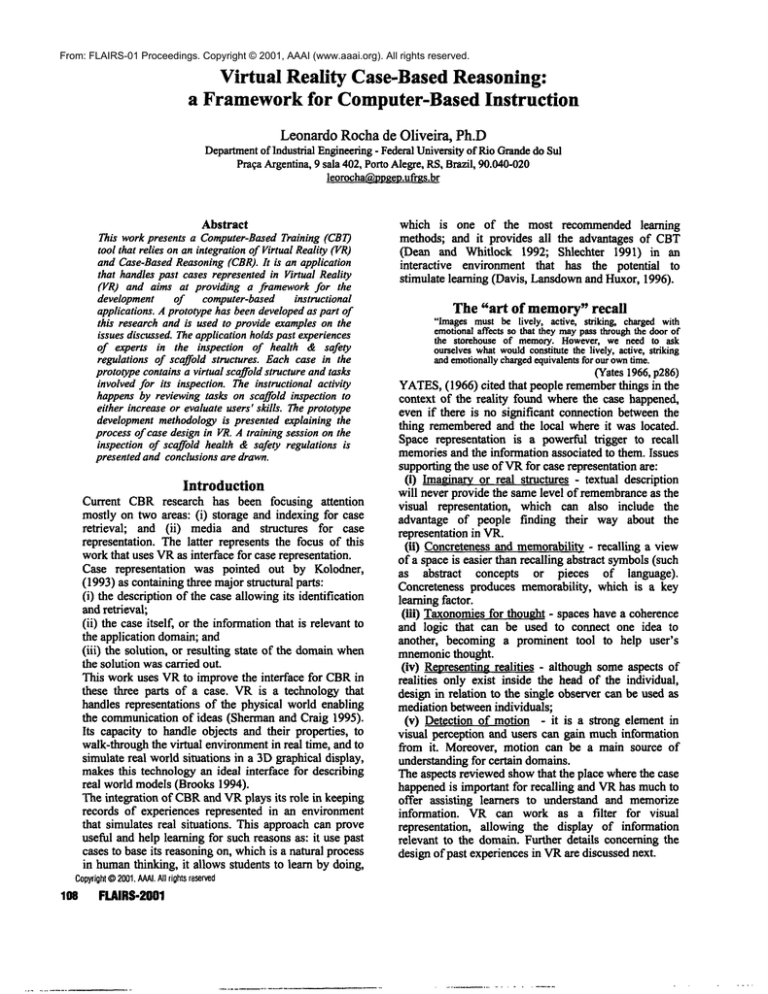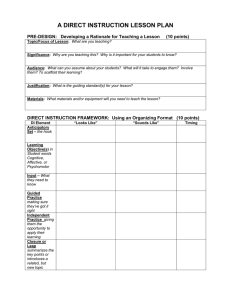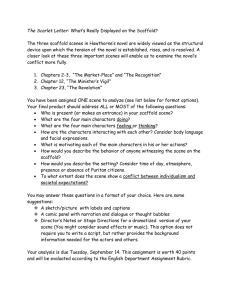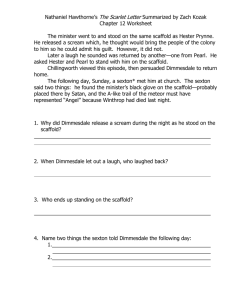
From: FLAIRS-01 Proceedings. Copyright © 2001, AAAI (www.aaai.org). All rights reserved.
Virtual Reality Case-Based Reasoning:
a Frameworkfor Computer-Based Instruction
Leonardo Rocha de Oliveira,
Ph.D
Department
of Industrial Engineering- FederalUniversityof RioGrandedo Sul
PraqaArgentina,9 sala 402, PortoAlegre,RS,Brazil, 90.040-020
leorocha@vv~,ep.ufrgs.br
Abstract
This workpresents a Computer-Based
Training (CBT)
tool that relies on anintegrationof VirtualReality(VR)
and Case-Based
Reasoning(CBR).It is an application
that handlespast cases representedin Virtual Reality
(VR) and aims at providing a framework for the
development of computer-based instructional
applications,d prototypehas beendevelopedas part of
this researchand is used to provide exampleson the
issues discussed.Theapplicationholds past experiences
of experts in the inspection of health & safety
regulations of scaffold structures. Eachcase in the
prototypecontainsa virtual scaffold structureandtasks
involvedfor its inspection. Theinstructionalactivity
happensby reviewingtasks on scaffold inspection to
either increaseor evaluateusers’ skills. Theprototype
developmentmethodologyis presented explaining the
processof casedesignin VR.A training session on the
inspectionof scaffold health &safety regulationsis
presentedandconclusionsare drawn.
Introduction
Current CBRresearch has been focusing attention
mostly on two areas: (i) storage and indexing for ease
retrieval; and (ii) media and structures for case
representation. The latter represents the focus of this
workthat uses VRas interface for case representation.
Case representation was pointed out by Kolodner,
(1993) as containingthree majorstructural parts:
(i) the description of the ease allowingits identification
and retrieval;
(ii) the case itself, or the informationthat is relevant
the application domain;and
(iii) the solution, or resulting state of the domainwhen
the solution wascarried out.
This work uses VRto improvethe interface for CBRin
these three parts of a case. VRis a technology that
handles representations of the physical world enabling
the communicationof ideas (Shermanand Craig 1995).
Its capacity to handle objects and their properties, to
walk-throughthe virtual environmentin real time, and to
simulate real worldsituations in a 3Dgraphical display,
makesthis technologyan ideal interface for describing
real world models(Brooks 1994).
The integration of CBRand VRplays its role in keeping
records of experiences represented in an environment
that simulates real situations. This approach can prove
useful and help learning for such reasons as: it use past
cases to base its reasoningon, whichis a natural process
in humanthinking, it allows students to learn by doing,
Copyright
©2001.
AAAI.
Allrights
reserved
108 FLAIRS-2001
which is one of the most recommended learning
methods; and it provides all the advantages of CBT
(Dean and Whitlock 1992; Shlechter 1991) in
interactive environment that has the potential to
stimulate learning (Davis, Lansdownand Huxor, 1996).
The "art of memory" recall
"Imagesmustbe lively, active, striking, chargedwith
emotional
affectssothat theymaypassthroughthe doorof
the storehouseof memory.However,we needto ask
ourselves
whatwouldconstitutethe lively, active,striking
andemotionally
charged
equivalents
for ourowntime.
(Yates1966,p286)
YATES,
(1966) cited that people rememberthings in the
context of the reality found where the ease happened,
even if there is no significant connection betweenthe
thing rememberedand the local where it was located.
Space representation is a powerful trigger to recall
memoriesand the information associated to them. Issues
supportingthe use of VRfor case representation are:
(i) Imaginaryor real structures - textual description
will never provide the same level of remembrance
as the
visual representation, which can also include the
advantage of people finding their way about the
representation in VR.
(ii) Concretenessand memorability- recalling a view
of a space is easier than recalling abstract symbols(such
as abstract concepts or pieces of language).
Concreteness produces memorability, which is a key
learningfactor.
(iii) Taxonnmiesfor thought - spaces have a coherence
and logic that can be used to connect one idea to
another, becoming a prominent tool to help user’s
mnemonicthought.
(iv) Representingrealities - although someaspects of
realities only exist inside the head of the individual,
design in relation to the single observer can be used as
mediation betweenindividuals;
(v) Detection of motion - it is a strong element in
visual perception and users can gain muchinformation
from it. Moreover, motion can be a main source of
understandingfor certain domains.
The aspects reviewedshowthat the place wherethe case
happenedis important for recalling and VRhas muchto
offer assisting learners to understand and memorize
information. VRcan work as a filter for visual
representation, allowing the display of information
relevant to the domain. Further details concerning the
design of past experiencesin VRare discussed next.
The CBRinterface
Dearden(1995)cited that the successof anyinteractive
intelligent system,whetherit is rule-based or casebased, is dependentnot only on the quality or on the
appropriatenessof the knowledgeencapsulatedwithin
the systembut also on the quality of the interactionthat
the systemsupports.
CBR
is a systemthat holds informationabout a problem;
organizes that information; searches in a store of
previous cases to find the ones that best matchthe
inputtedproblemandpresentsthe cases best matchedto
users. The users’ tasks includes interpreting and
understanding
the informationcontainedin those cases.
Thus, users have to at least interface with the CBR
system: to input the problem’s description; and to
receivethe informationcontainedin the caseretrieved.
In the first situation, currentCBR
interfacesoperateon a
level of inputtingtextual descriptionof case contents.
Dependingon the CBRshell and the structure used for
case representation, case description can also he made
by selecting case features frommenus.
The second situation deals with providing the
informationcontainedin a case, and this is whereVR
can play a major role. CBRapplications using
multimediatechniques,suchas sounds,pictures, image
animationanddigitized films, to better communicate
the
information contained in the cases. However,VR
representingpast cases allowsan interface whereusers
can interact with it andperformtheir ownexperiences.
TheVRinterface also allowsaccessto case featuresthat
are dynamicallydisplayedon the screenandcan be used
to facilitate memory
recall. Overall, increasingCBR’s
potential to provideCBTapplications as close to real
situations as computers
can provideis the mainreasonto
bring VRand CBRtogether.
Designing virtual cases
"It maybe that all human
beingshavethe sameperceptionof
spaceat the biologicallevel of perception.Butcertainlyevery
society uses its spacedifferently, bothtechnologicallyand
artistically"
(Bolter 1986,p80)
This workalso involvesthe constructionof the virtual
worldswherethe cases are held. This is a process of
design and, as such, there is no standard or common
sense operation or methodology
to be followed(Brooks
1994).
The developmentof this project has shownthat the
understandingof VRcapabilities andtheir influences
over the humanprocessof perceptionandcognition can
help decide whether VRis appropriate for case
representation.Moreover,
whatcan be built in VRis not
the only issue to consider in VRcase design. For
instance, aspects suchas the user interaction with the
virtual world, andthe wayit will be displayedshould
also be evaluated(Davis, Lansdown
andHuxor1996).
In orderto helpthoseinterestedin representingcasesin
VR,Table 1 shows aspects of reality and draws a
comparisonbetweenthree VRpackages.Developerscan
matchtheir needsto the VRpackagewhichcapabilities
best suit their application. TheVRpackagescompared
in this tableare:
SuperscapeVRTversion 5 (www.superscape.com)
Sense 8 WTK
version 6; (www.sense8.com);
and
Integrated Data Systems Inc. IDSV’RealmBuilder
(www.ids-net.com)
Table 1 considers only built-in functions of the VR
packages, avoiding need for skilful programmersto
include those aspects of reality in the applications.
Currently, most VRpackages contain a programming
languageandthus, in a way,mostof the aspectspresent
in this table can be achieved.However,if the aspect
requires programming,it has not been included "as
supported"
in this table.
Aspects of Reality
VRT
Extent
and
scalln
8
Yes
Height
Yes
Depth
Breadth
Yes
Object’s 3D movementpositionin8
Linear velocities
Yes
Translation
Yes
Rotation
Yes
Non-linearvelocities
Yes
Lighting
Light source
Yes
Yes
Distancin~
Direction
Yes
Spread
Yes
Different colors
Yes
Active
color
properties
Hue
Yes
Saturation
Yes
Passive
color properties
Transparency
Yes
Translucency
No
No
Reflectivity
Texture
Yes
Viewpoint
dynamics
3D freemovement
Yes
Variable
degree
offreedom
Yes
Fixin~
toobjects
Yes
Notto penetrate
someobjects Yes
Dependable
object
constraints No
Hierarchical object constraints
Yes
Object
properties
Mass
Yes
Volume
Yes
Hardness
No
Brittleness
No
Flexibility
No
Object
behavior
Gravity
Yes
Chan~e
colors
Yes
Expand
or contract
Yes
Reference
totheviewpoint
Yes
Responsive
sounds
Yes
WTK
IDS
Yes
Yes
Yes
Yes
Yes
Yes
Yes
Yes
Yes
Yes
Yes
Yes
Yes
Yes
Yes
Yes
Yes
No
Yes
Yes
Yes
Yes
No
Yes
Yes
Yes
Yes
Yes
No
No
No
Yes
No
No
No
Yes
Yes
Yes
No
Yes
No
Yes
Yes
Yes
No
No
No
Yes
Yes
No
No
Yes
No
No
No
No
No
No
No
Yes
Yes
Yes
Yes
No
Yes
Yes
Yes
No
Thistable canalsobe seenas critical successfactorsthat
can be usedto evaluateVRpackagessuitability for case
representationandproject development.
At the time this
CASEBASED
REASONING109
paper was written those listed were top PC packages.
They all are VRMLcompatible, although VRTand
WTKclaim that their own standards for delivering
applications through the Internet are currently more
comprehensiveand faster than VRML
(which is actually
true). However,ongoing developments in new VRtools
and technology related applications are expected to
improve representation of reality aspects, even for
delivering VRapplications through the Internet. Below
are listed some more issues that developers should
consider prior to choosing VRas CBRinterface:
- even whencase representation involves somesort of
spatial attributes, developers should ask themselves
whether
a 3D graphics
display
wouldreallyenhance
understanding;
- thecreation
ofvirtual
worlds
isa time-consuming
task
(thoughlibraries
of objectscan be builtup and
accelerate
the process)
anddevelopers
shouldbe
conscious
ofthis
factor;
- mostoftheworkinvolved
in building
VR worlds
is
uninteresting, repetitive and time consumingwith tasks
such as debugging,optimizing, and setting up;
- there is a danger that virtual worlds whenrunning on
different hardware may appear differently
from
developersoriginal intention.
Questions have been raised regarding the loss of
abstraction that VRentails and its possible counter
productive effect on understanding certain domains
(Davis, Lansdown and Huxor 1996). For instance,
Satalich (1995) describes a study wherethe users of
performed worse than a group who only worked on
paper. The sameauthor cited that the reasons supporting
these results could have been: the amountof time users
have been using VR, considering the novelty of the
technology; the issue and the wayit has been developed,
the learning evaluation methodology; and the
deficiencies of the hardwareused. The author suggests it
is worth keeping these results in mind. Howeverthere is
no reason to consider VRsystems as necessarily inferior
to traditional learning(Satalich 1995).
Developing a prototype
A prototype has been developedas part of this research
so as to explore the issues involving VRas an interface
to represent CBR’scases and actions. The objectives of
the prototyping stage were:
- helping to get feedback from the experts involved in
this research;
- identifying suitability of the CBRparadigm as a
training tool both for users and trainers;
- evaluating CBTdevelopment methodologies and their
role in this application;
- examining performance of personal computers to
handle
applications;
and
analysing
the potential
andweaknesses
of this
application
asanintelligent
training
toolthatkeeps
a
corporate
knowledge
ofthedomain.
The VR packageusedfor the development
of this
application
was Superscape
VRT version4.0.It
110
FLAIRS-2001
incorporates an environmentfor building VRworlds and
a programminglanguage that allowed the development
of the CBRengine and the structure of guidelines for the
training sessions. The following sub-sections provide
further details on the development
of this application.
Case representation
VRprovides an interface that users can interact with,
experiencingsimulations of the real world. However,the
creation of these virtual worlds, as discussed earlier, is
not an easy task. Issues concerning the application of
VRfor representation of past experiences, which have
been particularly important for the developmentof this
work, are"
presenting the cases in the way they have been
visualised by the eyes of the experts;
making cases useful in transmitting experts’
experiences;
displaying objects with the level of detail that is
required to properly evaluate the knowledgepresent in
the virtual case;
- ordering and interconnecting the information to be
displayed;
- providing descriptions for the cases in VRthat allow
proper matchingand retrieval; and
- handling the objects that belong to each of the cases
already in the repository to performcase adaptation.
The structure for case representation in the prototype
was implemented using the concept of Memory
Organisation Packets (MOPs)and Scripts described
Schank (1982) and Schank (1996). This concept says,
for instance, that a construction site with a scaffold
structure serves as a MOPfor an expert, and that the
several activities involved in its inspection constitute
what the concept calls a Script. Thus, each examination
of a scaffold is represented as a series of Scripts (or
tasks) that can be common
for other scaffold structures.
For instance, one of the cases present in the prototype
describes a site in which repairs will be done on the
rooftop of a three-store building. In order to identify
whether the scaffold complies with British Standards
regulations, sometasks have to be performed. One of
these tasks is to check whether the vertical bars
(technically called standards) are well centeredon top
soil plates. Any scaffold structure (which is not
suspended)must have its bases well centered on top of
soil plates. Thus, the task of inspecting if standardsare
properly supported by the soil plates is an exampleof a
Script that is common
for several MOPs.
Objects in a virtual worldare usually seen as buildings,
rooms,walls, pieces of furniture, etc. However,VRfiles
can also contain objects that are invisible for the
environment, but holding attributes responsible for
interfaces, animation, and computeralgorithms such as
functions,
rules and procedures.
Thus, case
representation by VRinvolves tasks that go beyondthe
3D modeling, such as the case description for future
retrieval, whichis discussednext.
Featuring cases for retrieval
Case featuring in the prototype results from the
combinationof three main issues: (i) the CBRparadigm
in terms of adoptingfeatures that differentiate the cases
in the repository and address themfor retrieval; (ii) the
requirements of CBT applications
in terms of
methodologiesto performtraining and learning; and (iii)
the capabilities of the object-oriented hierarchy used to
represent the cases in VR.
CBRguidelines for case retrieval prescribe that case
features should be useful in describing the case and
allowing its proper recognition and retrieval (Kolodner
1993; Watson1997). Training requirements indicate that
the process of designing the lessons can be one of the
most problematic aspects of CBT(Dean and Whitlock
1992). The usual approach goes from fairly general
knowledge(e.g. implications of health & safety on
scaffolding) to morespecific tasks (e.g. howto properly
inspect the scaffold foundations)(Shlechter 1991).
Redmond(1992) stated that CBRapplications for
training should also include two aspects: presenting the
same kind of situations users encounter on the job, as
well as carrying a presentation that will be properly kept
in the users’ memory.The same author indicates that
one of the challenges in building such systems regards
the ability to providefeatures for case retrieval that can
help users to access cases’ knowledge.
In this work, case featuring has been approached in
terms of describing scaffold structures and the tasks
involved in performing inspection of health & safety
regulations. Thus, features have been provided at two
levels: (i) at the top level describingthe cases, and(ii)
a lower level describing the Scripts each case contains.
Case features have been chosen in terms of descriptions
that differentiate the cases in the repository, such as the
type of scaffold, the type of workto be provided, type of
building, scaffold dimensionsand site characteristics.
Script features concern the description of the items and
tasks to performinspecting the scaffold structure. Both
levels of featuring havebeencarried out in close contact
with experts, whoalso provided guidelines for the task
sequenceto be followed performingscaffold inspection.
The object-oriented hierarchy used for the VRcase
representation held an importantrole in this workas it
allows access to the object’s properties of the virtual
cases. Advantagesthat can be taken from this access are:
- the possibility to create new cases by extracting and
combiningthe virtual cases;
- the possibility to create libraries containingobjects and
hierarchies that can be shared between users and
developers to speed up the process of case
representation; and
- the possibility to develop computer algorithms to
automatically performthe creation and featuring of new
cases by adapting from the objects-hierarchies, thus
avoidingthe usual difficulties associated to these timeconsumingtasks.
training performance
On real sites, experts do not need to follow a preestablished sequence inspecting health & safety
regulations on scaffold structures (though some
prescriptions exist). The usual approach is based on
checkingkey parts of the structure that allow experts to
identify whetherthe structure has beenproperly erected,
will be safe to work on, and safe for anyone in the
vicinity.
This freedom to choose the sequence of the tasks
inspecting scaffolds is quite in accordancewith the CBR
paradigm. CBRallows users the freedomto retrieve the
case they want, according to the input describing the
case.
The sameapproach has been included in this prototype,
whichhas also been designedto cater different levels of
users, such as (i) beginners blindly following systems
guidelines for the case retrieval sequence, (ii) users
experienced with the domainretrieving the script they
want to reinforce knowledge, and (iii) trainers
illustrating their lessons with a virtual representation of
past occurrenceson site.
I,J~ffNk 11 ~’
~1 4 S | 7 ¯ g 118 Cor~ Help
Fig. 3 - interface for case representation
Fig. 3 showsone of the cases present in the repository.
The menubar at the bottom prescribes a sequence of
scripts associated to the inspection on this structure.
Whenclicking the mouseover the script number, the
system presents guidelines on howto properly perform
the task associated to the number.Thus, the numberwill
change its colour on the menubar, indicating that the
task has been performed.
For instance, one script deals with the inspection on the
overhang at the end of the boards. The system’s
guidelines movethe viewpoint around the structure,
replicating the viewsthat an expert wouldhave on a real
site (see Fig. 3). Theoretical informationabout this task
is also provided by reading the menusor listening to an
expert’s advice.
Independently from the system’s guidelines, users can
freely walk-through the virtual case searching for
irregularities on the structure. Oncea irregularity is
found, users can click on the object and the systemwill
CASEBASEDREASONING 111
fix it. This approachis specially importantfor trainers,
who can use the system as a tool to illustrate site
occurrences. For instance, viewpointssuch as presented
on Fig. 4, could be difficult or dangerousto access even
on real structures. Moreover,trainees would need to
physically go to a site wherethis structure is present,
and special supervision wouldbe required.
There are very few, if any, domainsin which CBTcould
not be used to advantage learning (Shermanand Craig
1995). Oneof the mainreasons to choose CBTrelies on
providing good courseware at low cost. The experience
taken fromthis project expressthat thoughit shall not be
seen as a minimum
cost option, subsequent updates and
revisions should be possible at relatively low cost.
Therefore, CBTmaynot be seen as an approach to bring
best results in a short period of time.
References
t.No’Teek
1 2 3 4 $ 8 1; | 9 t0 CoMI o I~p
Fig. 4 - viewfromthe scaffold’s platform.
Most of the objects of the scaffold structure hold
additional information regarding dimensions, material
nomenclature, etc. This information can be accessed by
clicking on the right mousebutton on top of the virtual
object. Thus, each case works as a repository of
information concerning the domain of inspection of
health &safety regulations on scaffold structures.
Conclusions
Experiencingis a keywordrelated to VRand a dominant
characteristic of this application. In fact, VRallows
training by-doing or by-experiencing which is a
recommendedform of learning (Schank 1986, Sherman
and Craing 1995). The physical world simulation,
achieved by VR, which has an special meaning for
several domains, provides an interactive environmentto
help understandingof the performancesdisplayed.
The process of designing virtual worlds can be difficult
and time-consuming. However software for virtual
world building are becomingmore powerful day-by-day.
Moreover,third-party objects are becomingincreasingly
available and it will ease the process of virtual world
design. Modeling techniques to previously evaluate
objects’ behavior, dimensions, positions, dependencies
and links with other objects may help easing and
speeding up world creation.
CBRcan makeusers learn by: (i) having the opportunity
to access the structure and the contents of a past
experience; (ii) understandingthe content of a case and
its relevance to the domain,(iii) accessing the actions
and recommendations taken from the past case; (iv)
reasoning to solve new situations by establishing
comparisonswith similar cases in the repository, and (v)
creating new cases by adapting from the cases contained
in the repository.
112
FLAIRS-2001
BOLTER,
J.D. (1986). The Turing man: western culture
in the computerage. PenguinPublishers.
BROOKS,
M.R. (1994). Virtual reality interfaces for
complex environments. M.Sc. thesis, University of
Manchester.
DAVIS, S.B., LANSDOWN,
J., HUXOR,A. (1996).
The design of virtual environments. SIMAReport Series
n° 27, AGOCG- Advisory Group On Computer
Graphics, ISSN 1356-5370.
DEARDEN,
A.M. (1995). Improving the interfaces
interactive case memories. Prec. of the First United
KingdomCase-Based Reasoning Workshop. University
of Salford.
DEAN,C., WHITLOCK,
Q., (1992). A handbook
computer-basedtraining. KoganPage.
KOLODNER,
J.L., (1993). Case-based reasoning. San
Francisco, California: MorganKaufmann.
REDMOND
M.A. (1992) - Learning by observing and
understandingexpert problemsolving. Georgia Institute
of Technology, College of Computing.Technical Report
No. GIT-CC-92/43,Atlanta.
SATALICH,
G.A. (1995). Navigating and wayfinding
virtual reality: fmdingproper tools and cues to enhance
navigation awareness. Masters Thesis, HumanInterface
Technology Lab, University
of Washington,
http://www.hitl.washington.edu/publications/satalich/
(last
visited
05/99).
SCHANK,
R.C.,(1982).
Dynamicmemory:
a theory
reminding
and learningin computerand people.
Cambridge
University
Press.
SCHANK,
R. C.,(1996).
Goal-based
scenarios:
casebasedreasoning
meetslearning
by doing.
In:LEAKE,
D.B.(editor)
Case-based
reasoning:
experiences,
lessons
andfuture
directions.
AAAIPress/MIT
Press,
pp.295347.
SHERMAN,W.R.,CRAIG,A.B.(1995).Literacy
Virtual
Reality:
a NewMedium.
Computer
Graphics,
VOL29 (4),pp.37-41.
SHLECHTER,
T.M.,(1991).Problems
andpromises
computer-based
training.
Norwood,
N.J.:Ablex
Pub.
Corp.
YATES,F.A,(1966).The art of memory.Trafalgar
Square;
ISBN:071265545X.
WATSON,
I.,(1997).
Applying
case-based
reasoning:
techniques
forenterprise
systems.
MorganKaufmann
Publishers






